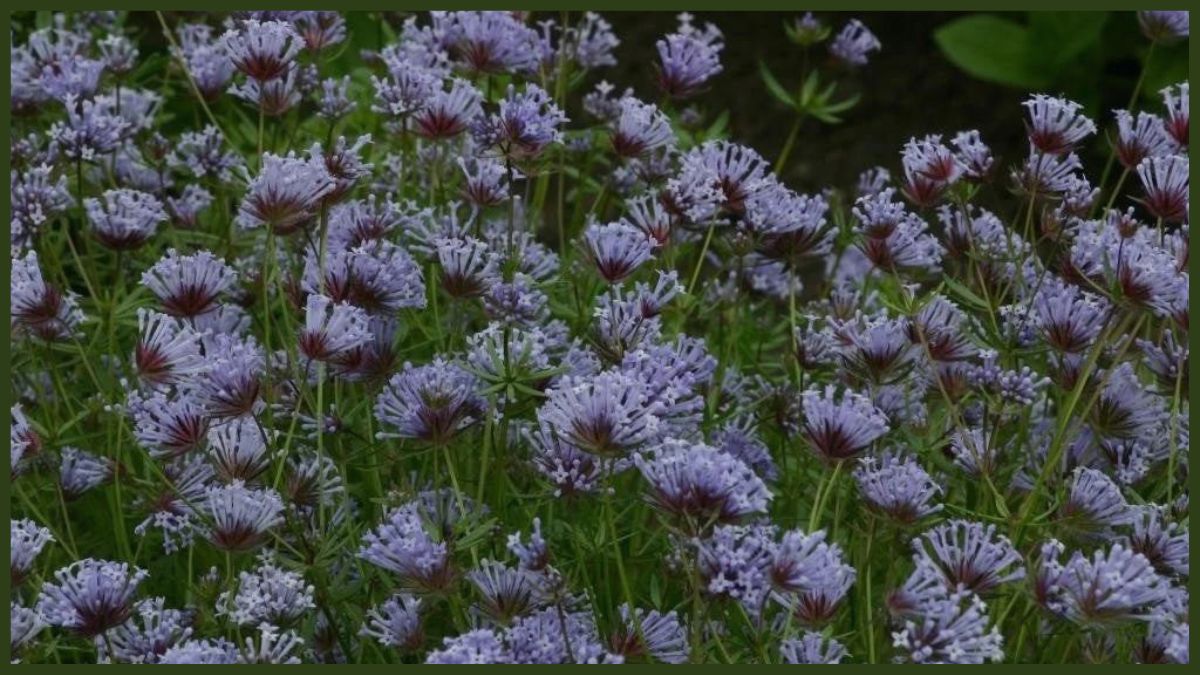Welcome to my blog! Today, I’ll be teaching you how to grow blue woodruff from seeds. This beautiful plant is native to Europe and Asia, and it’s perfect for adding a pop of color to your garden. With its delicate flowers and sweet fragrance, blue woodruff is a great addition to any home. So let’s get started!
blue woodruff (Asperula odorata) is a herbaceous perennial plant in the coffee family Rubiaceae. It is native to Europe, North Africa and West Asia. The plant has a creeping rootstock and forms mats of basal leaves from which erect leafy stems arise. The leaves are oval-shaped, hairless and have small teeth on their margins. Small white flowers with five petals appear in early summer, followed by fleshy, dark blue fruits.
Blue woodruff is cultivated as an ornamental plant for its attractive white flowers and blue fruits. It is also used as a culinary herb, both fresh and dried. In Germany, the plant is used to flavor the liqueur Waldmeister.
To grow blue woodruff from seeds, sow them in late winter or early spring just beneath the surface of moistened potting soil. Keep the soil moist but not wet and provide bright indirect light until germination occurs, which usually takes place within two to four weeks. Transplant seedlings into individual pots filled with light potting soil once they have developed their first true leaves. Place the pots in a sunny location outdoors and water regularly to keep the soil evenly moist.
What You’ll Need
To grow woodruff from seed, you’ll need:
- Woodruff seed
- A seed starting mix
- Peat pots
- A propagator or warm windowsill
Sow woodruff seeds in peat pots filled with a light, well-draining seed starting mix. Place the pots inside a propagator or on a warm windowsill and keep the mix moist but not wet. Seeds will germinate in 14-21 days. Once seedlings have reached 3-4 inches tall, transplant them into individual containers filled with regular potting soil.
Sowing the Seeds
To start blue woodruff from seed, sow the seeds indoors about 6 to 8 weeks before the last frost date in your area. Fill a planting tray or pot with a sterile soilless mix, and lightly dampen it. Sow the seeds on the surface of the mix, and press them down lightly. Don’t cover them with soil, as they need light to germinate. Place the tray or pot in a location that stays between 70 and 75 degrees Fahrenheit. Water the seedlings regularly to keep the soil moist, but not soggy.
Caring for Your Seedlings
Caring for your seedlings is not difficult, but there are a few things to keep in mind. Blue woodruff likes full sun, so make sure to put your seedlings in a spot where they will get at least six hours of sunlight each day. Blue woodruff is also a fairly drought-tolerant plant, so you don’t need to water it very often. Allow the soil to dry out completely between watering. Once your seedlings are established, they will only need to be watered every week or two.
Fertilizing is also not necessary, but if you want to give your plants a little boost, you can fertilize them once a month with a diluted all-purpose fertilizer. Blue woodruff is a relatively low-maintenance plant, so it does not require much pruning. If you want to keep it about two feet tall, you can simply trim off the tips of the tallest stems once or twice a year.
Transplanting Your Blue Woodruff
When transplanting your blue woodruff, it’s best to do so in the spring or fall. Choose a location that has well-drained soil and full sun. If you’re transplanting more than one plant, space them about 18 inches apart. To transplanted your blue woodruff:
- Water the plant thoroughly the day before you plan to transplant it.
- Using a spade or shovel,Carefully dig up the entire plant, making sure to get as much of the root system as possible.
- Gently loosen the roots and replant in the prepared hole.
- Water well and fertilize monthly with a balanced fertilizer.
Flowering and Fruiting
Blue woodruff (Asperula odorata) is a sweetly scented, herbaceous plant that produces small white flowers in clusters and fruits that resemble nuts. It is a native of Europe, but has been introduced to North America and other parts of the world. This plant prefers full sun to partial shade and moist, well-drained soil. It is tolerant of a wide range of soils, including clay. Blue woodruff is a short-lived perennial, but will self-seed readily.
To grow blue woodruff from seed, sow the seeds in late winter or early spring in a cold frame or on the surface of a well-drained seed starting mix. Lightly cover the seeds with soil and keep the soil moist but not wet. The seeds will germinate in 14-21 days at cool temperatures (60-70 degrees Fahrenheit). Once the seedlings have emerged, thin them so that they are spaced 6 inches apart. Transplant the seedlings into the garden after all danger of frost has passed. Space them 12 inches apart in full sun to partial shade.
Harvesting and Using Blue Woodruff
- The blue woodruff herb (Asperula odorata) is a charming and underutilized cottage garden plant with a long blooming season. It’s easy to grow from seed, and the dainty white flowers make a pretty addition to salads, desserts, and potpourris.
- This low-growing perennial is native to Europe and Asia, and it has been naturalized in North America. Blue woodruff is a member of the madder family (Rubiaceae), which also includes coffee (Coffea arabica), gardenia (Gardenia jasminoides), and pentas (Pentas lanceolata).
- The blue woodruff herb is best known for its fragrance. The delicate white flowers are used to flavor May wine, cordials, and syrups. The leaves can be used fresh or dried in potpourris. When the plant is in bloom, the whole stem can be cut and used as a decoration in vases.
- This charming little plant deserves a spot in more gardens! If you’d like to try growing blue woodruff, here are some tips.
Harvesting and Using Blue Woodruff
- Harvest the leaves of blue woodruff just before the plant blooms in late spring or early summer. You can dry them for use in potpourris, or use them fresh in salads or as a garnish for desserts.
- To dry blue woodruff leaves, tie them into small bundles and hang them upside down in a dark, well-ventilated room until they’re crisp. Store the dried leaves in an airtight container out of direct sunlight.
- The fragrant flowers of blue woodruff can be used fresh or dried to flavor May wine, cordials, syrups, and desserts. To dry the flowers, tie them into small bundles and hang them upside down in a dark room until they’re completely dry. Store the dried flowers in an airtight container out of direct sunlight.
Pests and Diseases
Pests and diseases can be a serious problem for blue woodruff (Asperula odorata). The most common pests include aphids, mites, and scale insects. These pests can cause damage to the leaves, stems, and flowers of the plant. Scale insects can also cause stunted growth.
Diseases that affect blue woodruff include powdery mildew, rust, and verticillium wilt. These diseases can cause yellowing leaves, stunted growth, and flower Buds to fall off the plant before they open.
Pests and diseases can be controlled with the use of pesticides or fungicides. However, it is important to read the labels carefully and follow the directions precisely to avoid harming the plants.
Tips and Tricks
Woodruff is a delightful plant to have in your garden. It is easy to grow and can be used in many ways. The most popular use for woodruff is as an herbal tea, but it can also be used in potpourris, sachets, and cosmetics.
Here are some tips and tricks for growing blue woodruff from seeds:
- Start seeds indoors about 6-8 weeks before the last frost date.
- Sow seeds on the surface of moist, well-draining potting mix or seed-starting mix. Press them gently into the mix but do not cover them.
- Place the pots in a warm spot (70-75 degrees Fahrenheit) and keep the soil moist but not wet.
- Seedlings will emerge in 14-21 days. Once they have two sets of true leaves, you can transplant them into individual pots.
- When night temperatures are consistently above 50 degrees Fahrenheit, you can acclimate your plants to outdoor conditions and then transplant them into the garden.
- Woodruff prefers a shady spot in the garden with moist, well-drained soil. It will tolerate some sun but will likely become leggy if it doesn’t get enough shade.
Conclusion
Now that you know how to grow blue woodruff from seeds, you can enjoy this flowers in your garden for many years to come. Be sure to deadhead spent blooms regularly to encourage continued flower production. With a little care, your blue woodruff will thrive and bring beauty to your landscape all season long!
Read Also:


My Hydrangeas burned up this year,only leaves came up,but no flowers.only the stalk is left,what to do to make them grow and spread more.